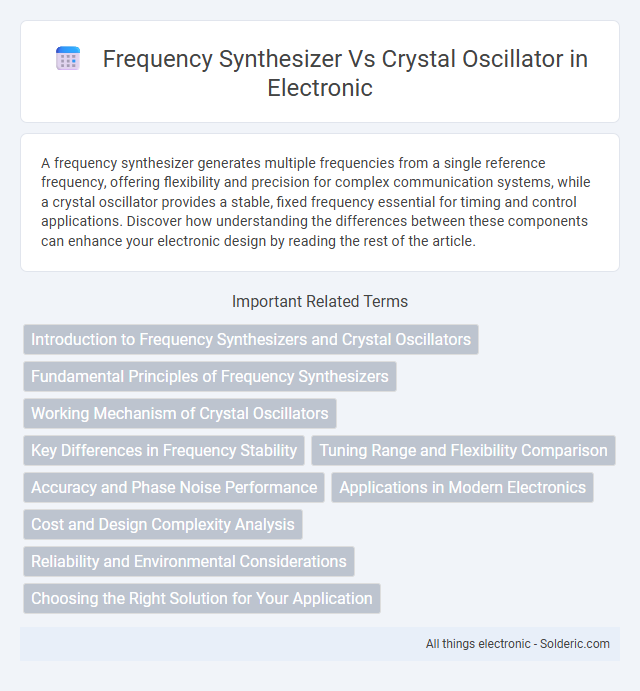A frequency synthesizer generates multiple frequencies from a single reference frequency, offering flexibility and precision for complex communication systems, while a crystal oscillator provides a stable, fixed frequency essential for timing and control applications. Discover how understanding the differences between these components can enhance your electronic design by reading the rest of the article.
Comparison Table
| Feature | Frequency Synthesizer | Crystal Oscillator |
|---|---|---|
| Function | Generates a range of frequencies from a fixed reference frequency | Generates a single, stable frequency using a quartz crystal |
| Frequency Stability | Good, depends on reference source | Very high, due to quartz crystal properties |
| Frequency Range | Wide and tunable | Narrow, fixed at a nominal value |
| Complexity | Higher, involves PLL and dividers | Simple circuit design |
| Cost | Higher due to components and complexity | Lower, inexpensive components |
| Applications | Communication systems, RF design, signal generation | Clocks, timers, microcontrollers |
| Phase Noise | Moderate, depends on design | Low phase noise |
Introduction to Frequency Synthesizers and Crystal Oscillators
Frequency synthesizers generate precise frequencies by combining or dividing reference signals, allowing for flexible and programmable output across wide frequency ranges. Crystal oscillators rely on the stable mechanical resonance of quartz crystals to produce a fixed, highly accurate output frequency, making them ideal for timing applications. While crystal oscillators provide excellent frequency stability, frequency synthesizers offer versatility for dynamic frequency generation in communication systems and signal processing.
Fundamental Principles of Frequency Synthesizers
Frequency synthesizers generate a range of frequencies from a single reference frequency using methods like phase-locked loops (PLL), direct digital synthesis (DDS), or frequency mixing, providing precise and agile frequency control. Crystal oscillators rely on the mechanical resonance of a quartz crystal to produce a stable, fixed frequency output with low phase noise, but lack the frequency flexibility of synthesizers. Your choice between these depends on whether you prioritize frequency stability or the ability to dynamically change frequencies within a system.
Working Mechanism of Crystal Oscillators
Crystal oscillators operate by exploiting the piezoelectric effect of quartz crystals, which vibrate at precise frequencies when an electric field is applied. These mechanical vibrations generate a stable sinusoidal signal that serves as a highly accurate frequency reference in electronic circuits. The inherent stability and low phase noise of crystal oscillators make them essential for timing applications in communications, instrumentation, and microprocessor clocking.
Key Differences in Frequency Stability
Frequency synthesizers offer adjustable output frequencies derived from a stable reference, but their frequency stability can be affected by phase noise and temperature variations, typically ranging around +-10 ppm. Crystal oscillators provide inherently superior frequency stability, often with deviations below +-0.1 ppm due to their quartz resonator's precise mechanical properties. In applications demanding high frequency accuracy and low drift, crystal oscillators outperform frequency synthesizers by maintaining consistent frequency stability over time and environmental changes.
Tuning Range and Flexibility Comparison
Frequency synthesizers offer a significantly wider tuning range compared to crystal oscillators, enabling precise frequency generation across broad spectrums from kilohertz to gigahertz. Crystal oscillators provide exceptional frequency stability but are limited to fixed, narrow frequency bands dictated by their physical crystal properties. Synthesizers are far more flexible in applications requiring rapid frequency switching and multiple frequency outputs, whereas crystal oscillators suit environments demanding long-term frequency accuracy with minimal drift.
Accuracy and Phase Noise Performance
Frequency synthesizers offer superior frequency accuracy and flexibility compared to crystal oscillators by generating precise output frequencies through digital control, allowing fine frequency resolution and stability. Crystal oscillators provide inherently low phase noise due to their high-quality quartz resonators, making them ideal for applications requiring minimal phase jitter. Your choice depends on whether ultra-low phase noise or programmable frequency accuracy is the priority for your system design.
Applications in Modern Electronics
Frequency synthesizers provide highly accurate and adjustable output frequencies essential for applications like wireless communication, radar systems, and signal processing, where frequency agility and stability are critical. Crystal oscillators generate precise, stable reference frequencies used in clocks, microcontrollers, and timing circuits crucial for consistent performance and synchronization in electronic devices. Your choice between these components depends on the need for flexibility versus fixed frequency stability in modern electronic applications.
Cost and Design Complexity Analysis
Frequency synthesizers typically involve higher design complexity and cost due to their reliance on phase-locked loops, voltage-controlled oscillators, and digital circuits to generate multiple frequencies. Crystal oscillators are more cost-effective and simpler in design, utilizing a quartz crystal to produce a stable, single-frequency output with minimal circuitry. The choice between the two depends on the application's frequency agility requirements and budget constraints.
Reliability and Environmental Considerations
Frequency synthesizers offer higher reliability in maintaining precise frequencies under varying environmental conditions due to advanced temperature compensation and digital control technologies. Crystal oscillators, while inherently stable in controlled environments, may be more susceptible to frequency drift caused by temperature fluctuations, vibration, and aging. Your choice between the two should consider the operational environment, with synthesizers favored for harsh or dynamic settings and crystal oscillators for applications requiring simplicity and cost-effectiveness.
Choosing the Right Solution for Your Application
Frequency synthesizers offer precise, adjustable output frequencies with low phase noise, making them ideal for applications requiring frequency agility like communication systems. Crystal oscillators provide stable, fixed frequencies with excellent temperature stability and low cost, suiting timekeeping and reference clock needs. Selecting the right solution depends on factors such as frequency range, stability requirements, power consumption, and cost constraints specific to your application.
Frequency synthesizer vs Crystal oscillator Infographic

 solderic.com
solderic.com